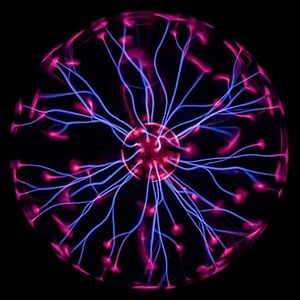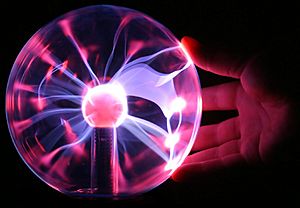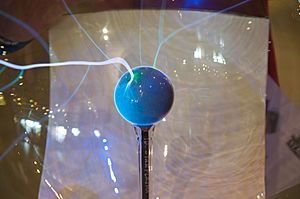Plasma globe facts for kids
A plasma globe (also called a plasma lamp or plasma ball) is a clear glass container. It is filled with a mix of special gases, like neon. In the middle of the globe is a special part that sends out electricity.
When electricity is turned on, a special kind of gas called plasma forms inside. Bright, wiggly lines of light, called plasma filaments, reach from the center to the glass. This makes it look like many colorful beams of light are dancing inside.
Plasma globes were very popular as fun novelty items in the 1980s.
The plasma lamp was first thought of by Nikola Tesla. He was experimenting with fast-moving electricity in empty glass tubes. He wanted to learn about very strong electricity.
Tesla called his invention an "inert gas discharge tube". Later, a student named Bill Parker at MIT created the modern plasma lamp design we see today.
How Plasma Globes Work
Most plasma lamps are clear glass balls. They are filled with a mix of gases, usually neon. Sometimes other special gases like argon, xenon, and krypton are added too. These gases are almost at the same pressure as the air around us.
Plasma lamps use fast-moving electricity. This electricity moves at about 35,000 times per second. It also has a high power, usually between 2,000 and 5,000 volts.
Inside the globe, bright lines of light, called plasma filaments, stretch from the center to the glass. These lines look like moving, colorful ribbons of light. If you put your hand close to the globe, you might smell a faint scent. This is ozone, a gas made when the strong electricity mixes with oxygen in the air.
When you touch the glass with your fingertip, it creates a special spot for the electricity to go. Your body can carry electricity better than the air around the globe. So, the energy from the plasma lines will move towards your finger. This makes a single line of light, from the center to your finger, become brighter and thinner.
The lines of light inside the globe move around a lot. This happens because the gas around the lines gets hot. When gas heats up, it becomes lighter and rises. This rising gas carries the bright lines of light with it.
A small electric current is also created in any object that is close to the globe. The glass acts like a barrier in a special electric setup. This setup is formed between the charged gas inside and your hand outside.
History of Plasma Globes
Nikola Tesla first described a type of plasma lamp in 1894. He called it an "Incandescent Electric Light." This was one of the first lamps that made light using a strong electric discharge.
Tesla used a light bulb-like glass globe with one metal part inside. He powered this part with strong electricity from a Tesla coil. This created bright, branching light inside. Tesla later called this his "Inert Gas Discharge Tube."
The "Groundstar" style of plasma globe was made by James Falk. He sold them to collectors and science museums in the 1970s and 1980s.
The special gas mixes used in today's plasma globes were not available to Tesla. Modern lamps often use mixes of xenon, krypton, and neon. These gas mixes, along with different glass shapes and modern electronics, create the bright colors and amazing patterns we see in plasma globes today.
See also
 In Spanish: Lámpara de plasma para niños
In Spanish: Lámpara de plasma para niños




